roof NISSAN JUKE 2017 F15 / 1.G Owners Manual
[x] Cancel search | Manufacturer: NISSAN, Model Year: 2017, Model line: JUKE, Model: NISSAN JUKE 2017 F15 / 1.GPages: 416, PDF Size: 2.62 MB
Page 11 of 416

0-2Illustrated table of contents
JVC0533X
1. Rear head restraints (Page 1-5)
2. Child restraint anchor points (for top tether strapchild restraint) (P.1-30, P.1-34)
3. Front head restraints (P.1-5) — Front-seat Active Head Restraints* (P.1-9)
4. Roof-mounted curtain side-impact and rollover supplemental air bags (P.1-38) 5. Seat belts (P.1-10)
6. Front seats (P.1-3)
7. Supplemental front-impact air bags (P.1-38)
8. LATCH (Lower Anchors and Tethers for CHil-
dren) system (P.1-20)
9. Rear seats (P.1-4) — Child restraints (P.1-18) 10. Front seat-mounted side-impact supplemental
air bags (P.1-38)
11. Seat belt with pretensioners (P.1-52)
12. Occupant classification sensors (weight sen- sors)
— Advanced Air Bag System (P.1-44)
13. Front passenger air bag status light (P.1-46)
*: if so equipped
SEATS, SEAT BELTS AND
SUPPLEMENTAL RESTRAINT
SYSTEM (SRS)
Page 12 of 416

JVC0977X
1. Hood (P.3-15)
2. Windshield wiper and washer— Switch operation (P.2-36)
— Blade replacement (P.8-15)
— Window washer fluid (P.8-9) 3. Parking lights, turn signal lights and front side
marker lights
— Switch operation (P.2-39)
— Bulb replacement (P.8-26)
4. Moonroof* (P.2-52)
5. Power windows (P.2-50)
6. Outside mirrors (P.3-22) 7. Side turn signal lights
— Switch operation (P.2-43)
— Bulb replacement (P.8-26)
8. Front view camera* (P.4-13)
9. License plate installation (P.10-13)
10. Fog lights* — Switch operation (P.2-44)
— Bulb replacement (P.8-26)
11. Headlights — Switch operation (P.2-39)
— Bulb replacement (P.8-23)
12. Tires — Wheels and tires (P.8-28, P.10-9)
— Flat tire (P.6-3)
— Tire Pressure Monitoring System (TPMS)
(P.2-18, P.5-3)
13. Side view camera* (P.4-13)
14. Doors — Keys (P.3-2)
— Door locks (P.3-4)
— Intelligent Key system (P.3-6)
— Security system (P.2-33)
*: if so equipped
Illustrated table of contents0-3
EXTERIOR FRONT
Page 15 of 416

0-6Illustrated table of contents
JVC0184X
1. Cargo area— Cargo cover* (P.2-49)
— Cargo light (P.2-55, P.8-23)
2. Coat hook (P.2-48)
3. Sun visors (P.3-21)
4. Microphone (P.4-80, P.4-89)
5. Moonroof switch* (P.2-52) 6. Room light and map lights (P.2-54)
7. Inside rearview mirror (P.3-21)
8. Door armrest
— Power window switch (P.2-50)
— Power door lock switch (P.3-5)
*: if so equipped
PASSENGER COMPARTMENT
Page 22 of 416

1 Safety — Seats, seat belts and supplementalrestraint system
Seats ........................................................................\
.................... 1-2
Front seats ........................................................................\
.... 1-3
Rear seats ........................................................................\
..... 1-4
Head restraints/headrests ....................................................... 1-5 Adjustable head restraint/headrest components ........ 1-6
Non-adjustable head
restraint/headrest components ........................................ 1-7
Remove ........................................................................\
.......... 1-7
Install ........................................................................\
.............. 1-7
Adjust ........................................................................\
............. 1-8
Front-seat Active Head Restraints (if
so equipped) ........................................................................\
1-9
Seat belts ........................................................................\
......... 1-10
Precautions on seat belt usage .................................... 1-10
Pregnant women .............................................................. 1-12
Injured persons ................................................................. 1-12
Three-point type seat belt .............................................. 1-12
Seat belt extenders .......................................................... 1-15
Seat belt maintenance .................................................... 1-15
Child safety ........................................................................\
...... 1-16 Infants ........................................................................\
.......... 1-17
Small children .................................................................... 1-17
Larger children .................................................................. 1-17 Child restraints ....................................................................... 1-18
Precautions on child restraints ................................... 1-19
Lower Anchors and Tethers for CHildren
System (LATCH) ............................................................ 1-20
Rear-facing child restraint installation
using LATCH ................................................................... 1-23
Rear-facing child restraint installation using the
seat belts ........................................................................\
.. 1-25
Forward-facing child restraint installation
using LATCH ................................................................... 1-28
Forward-facing child restraint installation using the
seat belts ........................................................................\
.. 1-30
Booster seats .................................................................. 1-34
Supplemental restraint system ........................................... 1-38 Precautions on supplemental restraint system ....... 1-38
NISSAN Advanced Air Bag System
(front seats) ..................................................................... 1-44
Front seat-mounted side-impact supplemental
air bag and roof-mounted curtain side-impact and
rollover supplemental air bag systems ..................... 1-51
Seat belts with pretensioners (front seats) ............. 1-52
Supplemental air bag warning labels ....................... 1-54
Supplemental air bag warning light .......................... 1-54
Repair and replacement procedure .......................... 1-55
Page 59 of 416

1-38Safety — Seats, seat belts and supplemental restraint system
PRECAUTIONS ON SUPPLEMENTAL
RESTRAINT SYSTEM
This Supplemental Restraint System (SRS)
section contains important information concern-
ing the following systems:
.Driver and passenger supplemental front-
impact air bag (NISSAN Advanced Air Bag
System)
. Front seat-mounted side-impact supple-
mental air bag
. Roof-mounted curtain side-impact and roll-
over supplemental air bag
. Seat belt with pretensioner
Supplemental front-impact air bag system:
The NISSAN Advanced Air Bag System can
help cushion the impact force to the head and
chest of the driver and front passenger in certain
frontal collisions.
Front seat-mounted side-impact supple-
mental air bag system: This system can help
cushion the impact force to the chest and pelvic
area of the driver and front passenger in certain
side impact collisions. The side air bag is
designed to inflate on the side where the vehicle
is impacted.
Roof-mounted curtain side-impact and
rollover supplemental air bag system: This
system can help cushion the impact force to the head of occupants in front and rear outboard
seating positions in certain side impact or
rollover collisions. In a side-impact, the curtain
air bags are designed to inflate on the side
where the vehicle is impacted. In a rollover, the
curtain air bags on both sides are designed to
inflate. Under both side-impact and rollover
situations, the curtain air bags will remain
inflated for a short period of time.
These supplemental restraint systems are de-
signed to
supplement the crash protection
provided by the driver and passenger seat belts
and are not a substitute for them. Seat belts
should always be correctly worn and the
occupant seated a suitable distance away from
the steering wheel, instrument panel and door
finishers. (See “Seat belts” (P.1-10) for instruc-
tions and precautions on seat belt usage.)
The supplemental air bags operate only
when the ignition switch is in the ON
position.
After the ignition is placed in the ON
position, the supplemental air bag warning
light illuminates. The supplemental air bag
warning light will turn off after about 7
seconds if the systems are operational.
SUPPLEMENTAL RESTRAINT
SYSTEM
Page 63 of 416
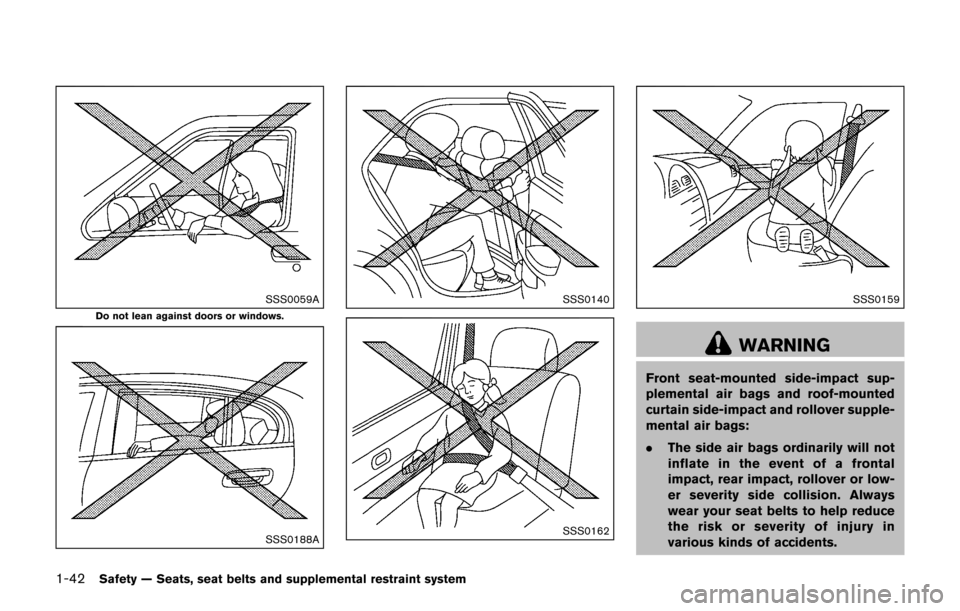
1-42Safety — Seats, seat belts and supplemental restraint system
SSS0059A
Do not lean against doors or windows.
SSS0188A
SSS0140
SSS0162
SSS0159
WARNING
Front seat-mounted side-impact sup-
plemental air bags and roof-mounted
curtain side-impact and rollover supple-
mental air bags:
.The side air bags ordinarily will not
inflate in the event of a frontal
impact, rear impact, rollover or low-
er severity side collision. Always
wear your seat belts to help reduce
the risk or severity of injury in
various kinds of accidents.
Page 64 of 416
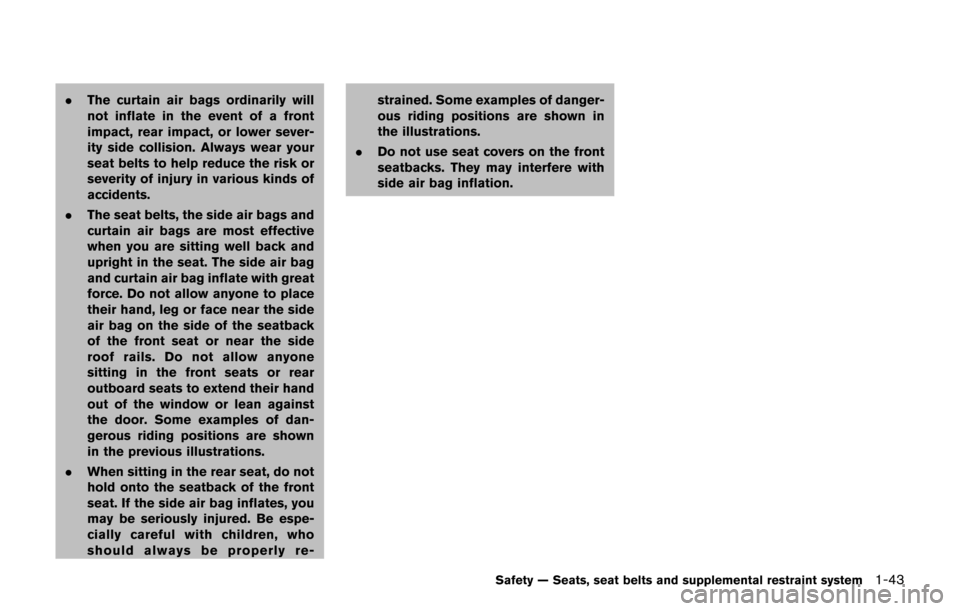
.The curtain air bags ordinarily will
not inflate in the event of a front
impact, rear impact, or lower sever-
ity side collision. Always wear your
seat belts to help reduce the risk or
severity of injury in various kinds of
accidents.
. The seat belts, the side air bags and
curtain air bags are most effective
when you are sitting well back and
upright in the seat. The side air bag
and curtain air bag inflate with great
force. Do not allow anyone to place
their hand, leg or face near the side
air bag on the side of the seatback
of the front seat or near the side
roof rails. Do not allow anyone
sitting in the front seats or rear
outboard seats to extend their hand
out of the window or lean against
the door. Some examples of dan-
gerous riding positions are shown
in the previous illustrations.
. When sitting in the rear seat, do not
hold onto the seatback of the front
seat. If the side air bag inflates, you
may be seriously injured. Be espe-
cially careful with children, who
should always be properly re- strained. Some examples of danger-
ous riding positions are shown in
the illustrations.
. Do not use seat covers on the front
seatbacks. They may interfere with
side air bag inflation.
Safety — Seats, seat belts and supplemental restraint system1-43
Page 65 of 416
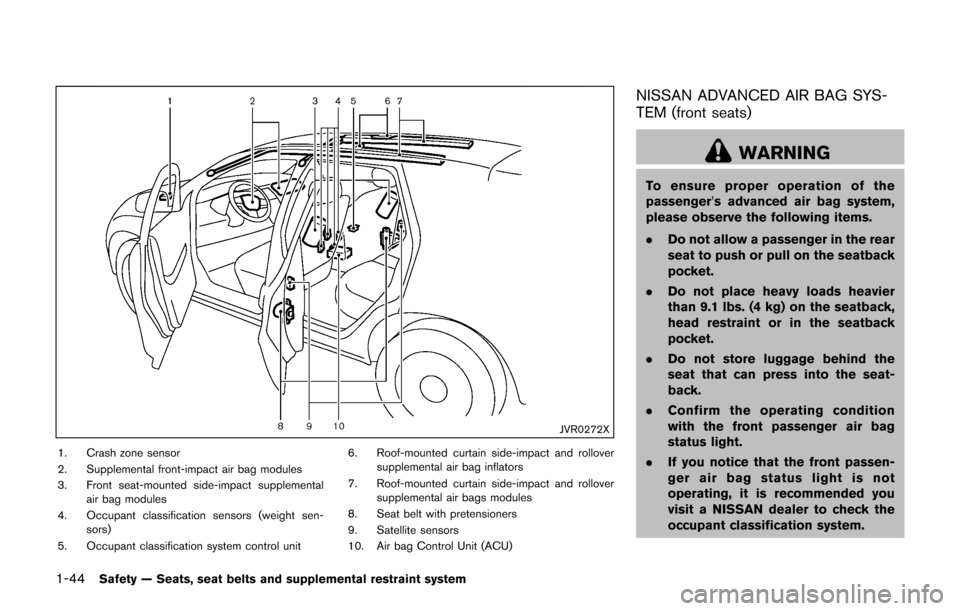
1-44Safety — Seats, seat belts and supplemental restraint system
JVR0272X
1. Crash zone sensor
2. Supplemental front-impact air bag modules
3. Front seat-mounted side-impact supplementalair bag modules
4. Occupant classification sensors (weight sen- sors)
5. Occupant classification system control unit 6. Roof-mounted curtain side-impact and rollover
supplemental air bag inflators
7. Roof-mounted curtain side-impact and rollover supplemental air bags modules
8. Seat belt with pretensioners
9. Satellite sensors
10. Air bag Control Unit (ACU)
NISSAN ADVANCED AIR BAG SYS-
TEM (front seats)
WARNING
To ensure proper operation of the
passenger’s advanced air bag system,
please observe the following items.
. Do not allow a passenger in the rear
seat to push or pull on the seatback
pocket.
. Do not place heavy loads heavier
than 9.1 lbs. (4 kg) on the seatback,
head restraint or in the seatback
pocket.
. Do not store luggage behind the
seat that can press into the seat-
back.
. Confirm the operating condition
with the front passenger air bag
status light.
. If you notice that the front passen-
ger air bag status light is not
operating, it is recommended you
visit a NISSAN dealer to check the
occupant classification system.
Page 72 of 416
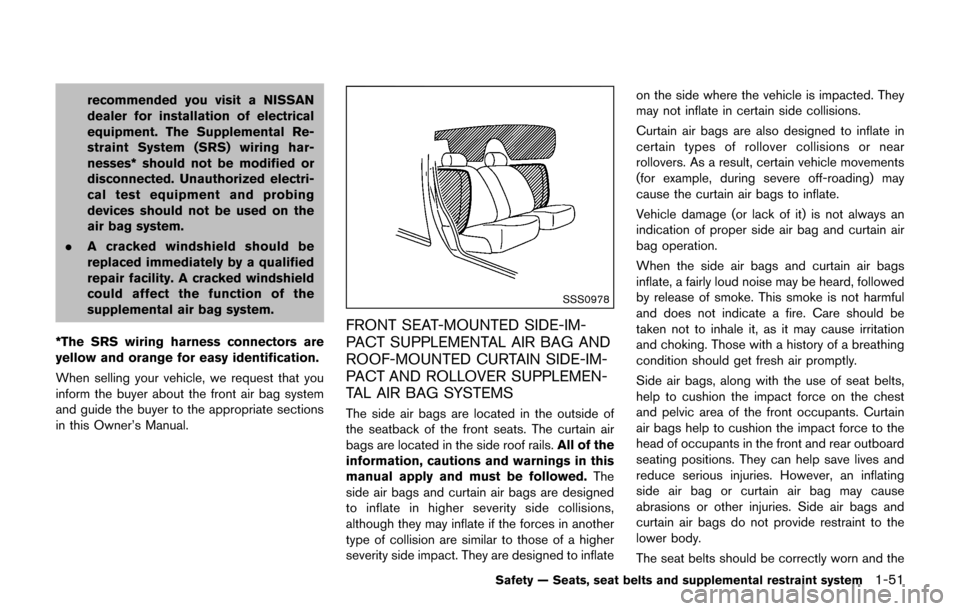
recommended you visit a NISSAN
dealer for installation of electrical
equipment. The Supplemental Re-
straint System (SRS) wiring har-
nesses* should not be modified or
disconnected. Unauthorized electri-
cal test equipment and probing
devices should not be used on the
air bag system.
. A cracked windshield should be
replaced immediately by a qualified
repair facility. A cracked windshield
could affect the function of the
supplemental air bag system.
*The SRS wiring harness connectors are
yellow and orange for easy identification.
When selling your vehicle, we request that you
inform the buyer about the front air bag system
and guide the buyer to the appropriate sections
in this Owner’s Manual.
SSS0978
FRONT SEAT-MOUNTED SIDE-IM-
PACT SUPPLEMENTAL AIR BAG AND
ROOF-MOUNTED CURTAIN SIDE-IM-
PACT AND ROLLOVER SUPPLEMEN-
TAL AIR BAG SYSTEMS
The side air bags are located in the outside of
the seatback of the front seats. The curtain air
bags are located in the side roof rails. All of the
information, cautions and warnings in this
manual apply and must be followed. The
side air bags and curtain air bags are designed
to inflate in higher severity side collisions,
although they may inflate if the forces in another
type of collision are similar to those of a higher
severity side impact. They are designed to inflate on the side where the vehicle is impacted. They
may not inflate in certain side collisions.
Curtain air bags are also designed to inflate in
certain types of rollover collisions or near
rollovers. As a result, certain vehicle movements
(for example, during severe off-roading) may
cause the curtain air bags to inflate.
Vehicle damage (or lack of it) is not always an
indication of proper side air bag and curtain air
bag operation.
When the side air bags and curtain air bags
inflate, a fairly loud noise may be heard, followed
by release of smoke. This smoke is not harmful
and does not indicate a fire. Care should be
taken not to inhale it, as it may cause irritation
and choking. Those with a history of a breathing
condition should get fresh air promptly.
Side air bags, along with the use of seat belts,
help to cushion the impact force on the chest
and pelvic area of the front occupants. Curtain
air bags help to cushion the impact force to the
head of occupants in the front and rear outboard
seating positions. They can help save lives and
reduce serious injuries. However, an inflating
side air bag or curtain air bag may cause
abrasions or other injuries. Side air bags and
curtain air bags do not provide restraint to the
lower body.
The seat belts should be correctly worn and the
Safety — Seats, seat belts and supplemental restraint system1-51
Page 73 of 416
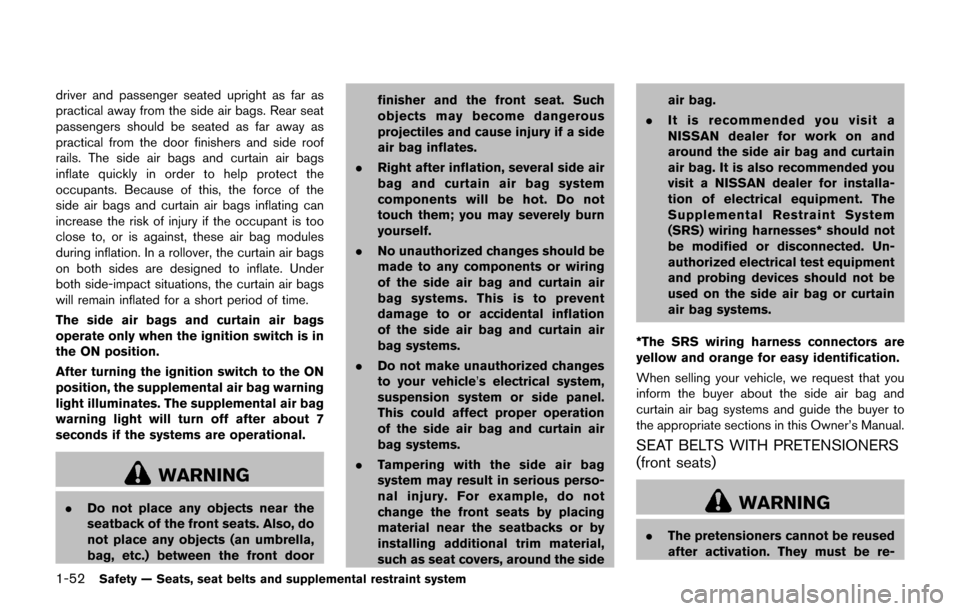
1-52Safety — Seats, seat belts and supplemental restraint system
driver and passenger seated upright as far as
practical away from the side air bags. Rear seat
passengers should be seated as far away as
practical from the door finishers and side roof
rails. The side air bags and curtain air bags
inflate quickly in order to help protect the
occupants. Because of this, the force of the
side air bags and curtain air bags inflating can
increase the risk of injury if the occupant is too
close to, or is against, these air bag modules
during inflation. In a rollover, the curtain air bags
on both sides are designed to inflate. Under
both side-impact situations, the curtain air bags
will remain inflated for a short period of time.
The side air bags and curtain air bags
operate only when the ignition switch is in
the ON position.
After turning the ignition switch to the ON
position, the supplemental air bag warning
light illuminates. The supplemental air bag
warning light will turn off after about 7
seconds if the systems are operational.
WARNING
.Do not place any objects near the
seatback of the front seats. Also, do
not place any objects (an umbrella,
bag, etc.) between the front door finisher and the front seat. Such
objects may become dangerous
projectiles and cause injury if a side
air bag inflates.
. Right after inflation, several side air
bag and curtain air bag system
components will be hot. Do not
touch them; you may severely burn
yourself.
. No unauthorized changes should be
made to any components or wiring
of the side air bag and curtain air
bag systems. This is to prevent
damage to or accidental inflation
of the side air bag and curtain air
bag systems.
. Do not make unauthorized changes
to your vehicle’s electrical system,
suspension system or side panel.
This could affect proper operation
of the side air bag and curtain air
bag systems.
. Tampering with the side air bag
system may result in serious perso-
nal injury. For example, do not
change the front seats by placing
material near the seatbacks or by
installing additional trim material,
such as seat covers, around the side air bag.
. It is recommended you visit a
NISSAN dealer for work on and
around the side air bag and curtain
air bag. It is also recommended you
visit a NISSAN dealer for installa-
tion of electrical equipment. The
Supplemental Restraint System
(SRS) wiring harnesses* should not
be modified or disconnected. Un-
authorized electrical test equipment
and probing devices should not be
used on the side air bag or curtain
air bag systems.
*The SRS wiring harness connectors are
yellow and orange for easy identification.
When selling your vehicle, we request that you
inform the buyer about the side air bag and
curtain air bag systems and guide the buyer to
the appropriate sections in this Owner’s Manual.
SEAT BELTS WITH PRETENSIONERS
(front seats)
WARNING
. The pretensioners cannot be reused
after activation. They must be re-